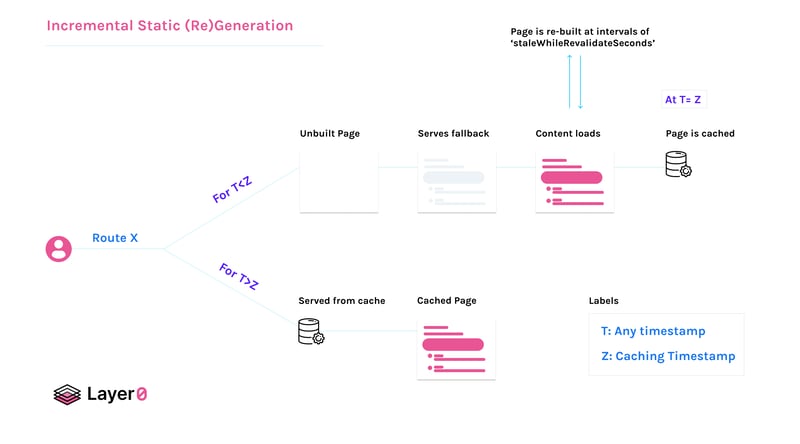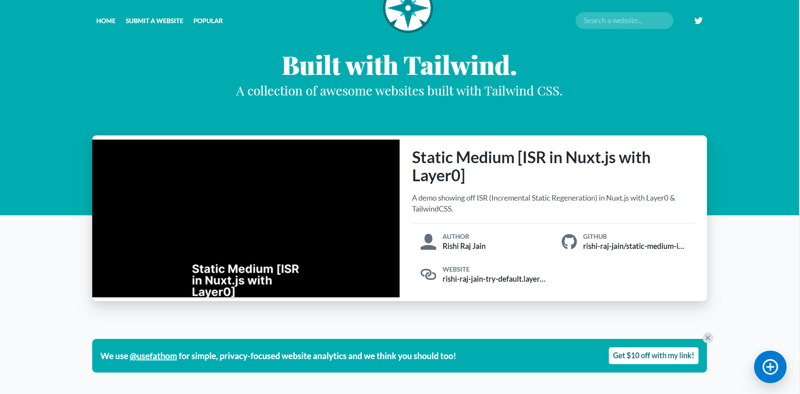What is Incremental Static (Re)Generation?
For understanding Incremental Static Generation, let the explanation be guided by a scenario where a page requested by the user was not pre-rendered while statically exporting the website. In such a case, a fallback page is served while the data loads. Further, upon completion of building the page with the fetched data, the page is then cached onto the server. Any user requesting the page then would skip over the fallback and loading stages, and directly see the built page. Superb!
Regeneration is inspired by the concept of stale-while-revalidate, where stale data is refreshed at regular intervals of 'revalidate' seconds. For pages that have staleWhileRevalidateSeconds value configured, they would be re-built after regular intervals of the configured value.
Refer to the detailed guides on ISR at: Incremental Static Regeneration: Its Benefits and Its Flaws and A Complete Guide To Incremental Static Regeneration (ISR) With Next.js
This can be followed up by two questions:
- Does that allow the pre-rendered pages to be regenerated during runtime? Yes, the pre-rendered pages when deployed would also be 'revalidated' after intervals of staleWhileRevalidateSeconds seconds.
- Can new dynamic pages be generated during runtime without using SSR? While there can be client side rendering for the pages that are being built at runtime (i.e. serving the fallback), avoiding SSR altogether for ISG seems unfeasible.
Benefits of ISR
With Incremental Static Generation and Regeneration, creates the possibility to initially have the minimal static export, and then create and regenerate the pages on-demand, without re-building the website. This would account to faster deployments, hassle-free handling of regenerating the pages without the need to re-build the website.
Drawbacks of ISR
As the concept is inspired by stale-while-revalidate, the data is certain to be stale for a period. This nature might be undesired for a web product that aims to serve fresh content for each user. Using ISG or ISR would lead to serving the content that is yet to be updated for some set of the users (those who hit it before revalidation time), or might show the fallback for some (those who hit it after maxAgeSeconds time). This might lead to degraded user experience, but that is very specific to the use case.
Getting started with ISG in Nuxt.js with Layer0
This section will describe how to implement ISG with Layer0 and Nuxt.js. The steps include configuring a nuxt app with layer0, creating dynamic page and api routes, and finally using layer0 configurations to see ISG in action.
Configuring Nuxt.js app with Layer0
Create a Nuxt.js app by the following command:
npm create nuxt-app <project-name>
- For Choose custom server framework select None
For Choose rendering mode select Universal (SSR)
In case you already have a nuxt app, just maintain the above configurations and would be good to go.Add the Layer0 CLI via:
npm i -g @layer0/cliIn nuxt.config.js, add "@layer0/nuxt/module" to buildModules:
module.exports = {
buildModules: [
[
'@layer0/nuxt/module',
{
layer0SourceMaps: true
}
]
]
}
- Run
layer0 init
Run the Nuxt.js app locally on Layer0
Run the Nuxt.js app with the command:
npm run layer0:dev
Creating dynamic page and api routes
Set up dynamic page routes
Nuxt makes it super easy to create dynamic pages. To set up a dynamic route, create a file _slug.vue in some-route folder in pages directory of your app.
To obtain the dynamic parameter slug, nuxt provides a data fetching hook asyncData which has access to the context object. For example, in the following pages/some-route/_slug.vue dynamic page, one can obtain the slug via params.slug to make data fetching calls before the page gets rendered.
Set up dynamic api routes
To set up dynamic api routes, nuxt provides a server middleware can also extend Express which allows creation of REST endpoints
For example, the following server-middleware/rest.js will fetch and return data for all the endpoints that start with /api/some-route/ and ends with .json.
Layer0 ISG Goodies
- For ISG, use routes.js (Created automatically by layer0 init command) and add route for the dynamic pages
/some-route/_slug.vueand the dynamic api route/api/some-route/:slug.jsonas in the gist below:
Testing and Deployment
To test locally how the app would do in production, run the following:
layer0 build && layer0 run --productionTo deploy run:
layer0 deployCelebrate! 🎉
Example Of Incremental Static Generation with Layer0
With Layer0, it's easier than ever to implement Incremental Static Generation for different purposes with different frameworks. The following seeks to implement ISG with Nuxt.js via Layer0.

GitHub: https://github.com/rishi-raj-jain/static-medium-isr-in-nuxtjs-with-layer0
Website: Static Medium








Top comments (0)